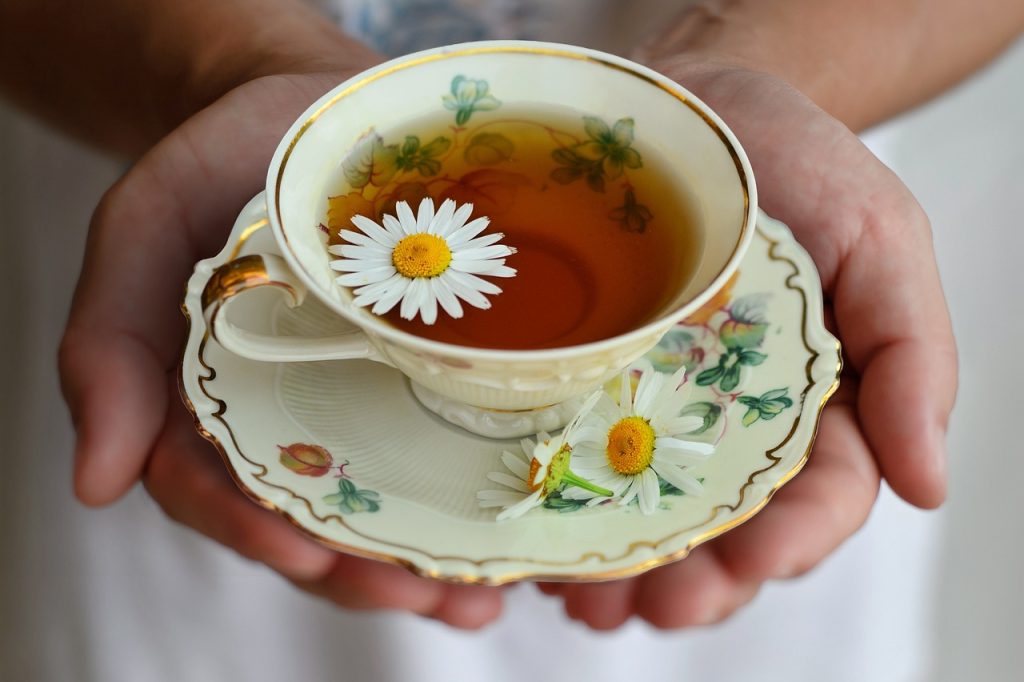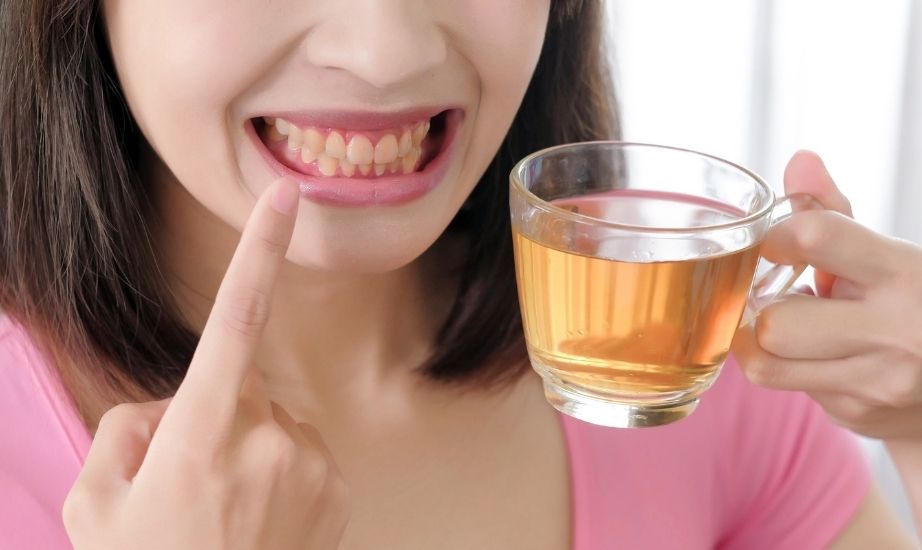Chamomile tea, renowned for its calming properties and delightful aroma, has been a beloved beverage for centuries. With its origins rooted in ancient civilizations, it has been celebrated not just for its soothing effects on the mind but also for the myriad of health benefits it is believed to offer, ranging from aiding digestion to boosting immunity.
As tea enthusiasts and health-conscious individuals have reached for their daily cup of chamomile, a recurring question has surfaced: what impact does this light-colored herbal infusion have on the color of our teeth? We’re all familiar with the warnings about coffee, red wine, and dark teas – drinks notorious for their teeth-staining potential. But where does chamomile tea fit in this spectrum?
In the modern era, with an emphasis on pearly white smiles, understanding the effects of our dietary choices on tooth color has become increasingly relevant. With that in mind, this article delves into the relationship between chamomile tea and teeth staining, presenting you with the facts and offering guidance on how to enjoy your tea without compromising your smile.
Whether you’re a devoted chamomile drinker or someone just exploring its benefits, this piece aims to provide clarity on a topic that has left many wondering.
Does Chamomile Tea Stain Teeth?
At a glance, chamomile tea, with its pale golden hue, doesn’t seem like a candidate for staining teeth, especially when compared to its deeper-hued counterparts like black or green tea. But to truly answer this question, it’s essential to understand the elements at play.
1. Tannins and Chamomile Tea
Tannins are polyphenolic compounds found in many beverages and foods, especially teas. They’re known to bind to proteins and other organic compounds, including the enamel on our teeth. This binding can result in discoloration over time.
Recommended: What Does Jasmine Milk Tea Taste Like?
When it comes to chamomile tea, the good news is that it has significantly lower tannin content than black or green tea. This means that the risk of staining from tannins in chamomile tea is markedly lower.
2. Natural Color Pigments
While tannins are a primary staining agent in many teas, they aren’t the sole factor. Beverages can also contain natural color pigments that might deposit on the teeth. Chamomile tea gets its gentle golden color from its chamazulene content. However, chamazulene does not possess the strong staining properties of tannins.
3. Other Compounds
Apart from tannins and natural pigments, other compounds in the tea can contribute, albeit minimally, to discoloration. It’s worth noting, though, that these are generally present in far lower concentrations and hence their staining effect is relatively mild.
Generally speaking, chamomile tea is less likely to stain teeth compared to darker beverages like black tea or coffee. However, that doesn’t mean it’s entirely stain-free. Given its lower tannin content and the nature of its pigments, the staining potential is minimal, especially if consumed in moderation.
Recommended: What a Tea Bag Does In Warm Water Crosswood
Still, as with any beverage, frequency, oral hygiene, and individual enamel composition play crucial roles in how it might affect tooth color.

Factors that Contribute to Tea Staining
When it comes to staining teeth, not all teas are created equal, and various factors come into play. Understanding these can help tea lovers make informed decisions and adopt habits to minimize potential discoloration. Here are the factors to consider:
1. pH Level of the Drink
- Acidity and Enamel: A drink’s pH level determines its acidity. Beverages with a lower pH (more acidic) can erode the protective enamel on our teeth. Once this enamel starts eroding, it exposes the underlying dentin, which is naturally yellower and more susceptible to staining.
- Chamomile’s pH: While chamomile tea is mildly acidic, its pH isn’t as low as some fruit juices or sodas. However, it’s always good to be mindful, as any level of acidity can contribute to enamel erosion over prolonged exposure.
2. Temperature at which the Tea is Consumed
- Pores in the Enamel: Teeth, like our skin, have pores. Hot beverages can cause these pores to open more, making teeth more vulnerable to staining agents.
- Ideal Consumption Temperature: To lessen the potential for staining, consider waiting a few minutes after brewing your tea to let it cool down slightly before drinking.
3. Length of Steeping Time
- Tannin Release: The longer tea leaves (or tea bags) steep in hot water, the more tannins they release. Even though chamomile has lower tannin content, over-steeping can still increase its concentration in the tea.
- Recommendation: For optimal flavor and minimal staining, it’s often best to follow the recommended steeping times. For chamomile, that’s usually around 5 minutes.
4. Individual’s Tooth Enamel and Oral Hygiene
- Variability in Enamel: Everyone’s enamel structure is slightly different. Some may have naturally porous enamel, making them more susceptible to staining from various foods and drinks.
- Oral Hygiene: Regular brushing, flossing, and dental check-ups play a significant role in preventing and reducing stains. Proper toothbrushing techniques can help remove potential staining agents before they set in. Moreover, using toothpaste with mild abrasives can aid in gently removing superficial stains.
Recommended: Does Panera Green Tea Have Caffeine?
By being aware of these factors and making minor adjustments in our tea-drinking habits, it’s possible to continue enjoying our favorite brews without undue concern about their staining potential.
Comparison with Other Beverages
While chamomile tea’s gentle hue might raise questions about its staining potential, it’s essential to contextualize it within the vast spectrum of beverages. Let’s dive into how chamomile stacks up against other popular drinks known for their staining capacity.
1. Coffee
- Color and Tannins: Coffee is a prime suspect when it comes to teeth staining. Its dark color and high tannin content make it a potent stainer. Over time, regular coffee consumption can lead to a brownish tinge on the teeth.
- Relative Staining Potential: Compared to chamomile, coffee poses a significantly higher risk for staining teeth.
2. Red Wine
- Acidic and Rich in Tannins: The deep red hue of red wine comes from chromogens, and its tannin content further accentuates its staining ability. The acidity in wine can also erode enamel, making teeth more vulnerable to staining.
- Relative Staining Potential: Red wine is more likely to stain teeth than chamomile tea, especially when consumed regularly.
3. Black Tea
- Dark Color and High Tannin Content: Black tea, owing to its processing method, has a darker color and higher tannin concentration than chamomile. This makes it a more potent stainer.
- Relative Staining Potential: Black tea will generally stain teeth more noticeably than chamomile, especially if it’s brewed strong and consumed frequently.
4. Green Tea
- Mildly Staining: Green tea, while lighter in color than black tea, still contains tannins that can stain teeth. However, its staining potential is less aggressive than that of black tea.
- Relative Staining Potential: Green tea might cause some discoloration over time, especially with regular consumption, but it’s still less staining than coffee or black tea. Compared to chamomile, green tea poses a slightly higher risk of staining.
5. Fruit Juices and Sodas
- Acidic Nature: Many fruit juices, especially those like grape and cranberry, are not only rich in color but also quite acidic. Similarly, sodas, both colored and clear, are highly acidic. This acidity can erode enamel, making teeth more susceptible to stains from other foods and drinks.
- Relative Staining Potential: While the color of fruit juices might not stain as aggressively as coffee or red wine, acidity can be a concern. Compared to chamomile, many fruit juices and sodas can be more damaging in terms of enamel erosion and subsequent staining.
Recommended: Is Chai Tea Good For Sore Throat?
Chamomile tea’s potential for staining is relatively low when compared to many popular beverages. While it’s not completely devoid of staining agents, its impact on tooth color is minor, especially when enjoyed in moderation and combined with good oral hygiene practices.
As always, being informed about the beverages we consume allows us to make choices that align with our health and aesthetic goals.
Tips to Minimize Staining from Chamomile Tea
Chamomile tea’s gentle nature and myriad benefits make it a favorite for many. Though its staining potential is relatively low compared to other beverages, it’s always beneficial to adopt habits that protect your smile. Here are some tried-and-true tips to keep those pearly whites shining:
1. Drinking Water Afterwards
- Natural Rinse: After finishing your cup of chamomile tea, take a moment to swish some water around in your mouth and then swallow or spit it out. This simple act can help wash away any potential staining agents left behind.
- Hydration Benefits: Drinking water not only helps with potential stains but also promotes hydration—beneficial for overall health and well-being.
2. Using a Straw
- Less Direct Contact: By using a straw, especially one angled away from the front teeth, you can limit the direct contact the tea has with your teeth. This is especially useful for those who are particularly concerned about any discoloration.
- Eco-Friendly Options: If you’re concerned about the environmental impact of plastic straws, consider reusable options like stainless steel, bamboo, or glass straws.
3. Avoid Holding the Tea in Your Mouth
- Prolonged Exposure: Holding or swishing tea in your mouth increases the contact time between the tea and your teeth, which could raise the risk of staining.
- Quick Sips: It’s best to take a sip and swallow relatively quickly, minimizing the tea’s contact with your teeth.
4. Regular and Proper Dental Hygiene
- Brushing: Aim to brush your teeth at least twice a day, preferably in the morning and before bed. If you’re an avid tea drinker, consider brushing or rinsing your mouth after drinking.
- Flossing: Regular flossing helps to remove plaque and particles between your teeth, areas where potential staining agents can linger.
- Mouthwash: Using an antimicrobial or fluoride mouthwash can further help to cleanse the mouth and reduce the risk of staining.
5. Regular Dental Check-ups
- Professional Cleaning: Dentists and dental hygienists can remove surface stains during routine cleanings. Regular check-ups, typically twice a year, can ensure your teeth stay in optimal condition.
- Consultation: If you’re concerned about any discoloration, discuss it with your dentist. They can provide insights, recommendations, or even professional whitening options if needed.
6. Limit Steeping Time
As mentioned earlier, the longer you steep your tea, the more tannins are released. For chamomile, try to stick to the recommended 5 minutes to enjoy the flavor without unnecessary tannin release.
7. Consider Tooth-Whitening Products
- Whitening Toothpaste: These contain mild abrasives that can help polish away surface stains and ingredients that can help prevent new stains from forming.
- At-home Whitening Kits: If you’re looking for a more intensive solution, consider over-the-counter whitening strips or trays. However, always follow instructions and consult with a dentist to ensure you’re using them safely.
Recommended: Slimming Pills For Lactating Moms: Our Top 5 Picks
By incorporating these tips into your daily routine, you can confidently sip your chamomile tea without worrying about its impact on your radiant smile.

Natural Whitening Solutions for Tea Drinkers
For those who enjoy their daily cup of tea but are mindful of maintaining a sparkling smile, natural whitening solutions can be an attractive option. These remedies leverage everyday household or kitchen items, offering an eco-friendly and often cost-effective alternative to commercial products. Here’s an expanded look into natural ways to counteract potential staining from teas:
1. Baking Soda and Water Paste
- How it Works:Baking soda is mildly abrasive, which means it can gently scrub away surface stains on teeth.
- Application: Mix a small amount of baking soda with water to form a paste. Brush this onto your teeth gently using a toothbrush. Rinse thoroughly afterward. Use this method once a week or as needed, but not daily as excessive use can erode enamel.
2. Oil Pulling with Coconut Oil
- How it Works: An ancient Ayurvedic practice, oil pulling involves swishing oil in your mouth to “pull out” bacteria, potentially leading to a brighter smile.
- Application: Take a tablespoon of organic, virgin coconut oil and swish it around in your mouth for 15-20 minutes. Spit it out (preferably in a trash can to avoid clogging pipes), and then rinse your mouth with water. Brush your teeth as usual.
3. Consuming Crunchy, Water-Rich Fruits and Vegetables
- How it Works: Crunchy foods like apples, celery, and carrots act as natural toothbrushes. They can help scrub away food particles and bacteria, providing a mild cleaning effect.
- Application: Incorporate these crunchy fruits and vegetables into your diet regularly. Eating them raw maximizes their teeth-cleaning potential.
4. Strawberry and Baking Soda Paste
- How it Works: Strawberries contain malic acid, which could help remove surface discoloration. Combined with baking soda’s abrasive properties, it can offer a natural whitening effect.
- Application: Mash up one or two ripe strawberries and mix with a half teaspoon of baking soda. Spread the mixture over your teeth using a toothbrush or your finger. Leave it on for a few minutes, then rinse and brush your teeth thoroughly. Use this method occasionally, as frequent use could damage the enamel.
5. Activated Charcoal
- How it Works:Activated charcoal can bind to compounds, including those that stain teeth. It’s often used in emergency medicine to treat poisonings due to its ability to trap chemicals.
- Application: Wet your toothbrush and dip it into powdered activated charcoal. Brush your teeth gently with the charcoal for 2 minutes. Spit and rinse until the water runs clear. Use this method occasionally, as overuse can be abrasive.
6. Dairy Products
- How it Works: Dairy products, especially hard cheeses, can help neutralize the acids in your mouth, potentially reducing the risk of enamel erosion. Furthermore, they contain proteins that bind to teeth and protect against acid-producing bacteria.
- Application: Incorporate more dairy into your diet, like finishing a meal with a piece of cheese.
7. Hydrogen Peroxide
- How it Works: A natural bleaching agent, hydrogen peroxide can help whiten teeth.
- Application: Mix equal parts of hydrogen peroxide with water and use it as a mouthwash. Ensure not to swallow any of the solution. Additionally, you can create a paste with baking soda and hydrogen peroxide and brush gently. Use this sparingly to avoid gum irritation.
Recommended: Side Effects Of Caffeine On The Body You Must Know
While natural solutions can be beneficial, it’s essential to approach them with care. Always do a patch test or consult with a dental professional before trying any new oral health regimen, especially if you have sensitive teeth or gums. Furthermore, natural doesn’t always mean safe, so it’s crucial to be informed and cautious.
Conclusion
Chamomile tea, with its myriad benefits and soothing nature, remains a favored choice for many. While its staining potential is notably less than that of darker beverages, being proactive in oral care can further mitigate any risks.
By understanding the factors contributing to staining and employing both preventive and natural whitening techniques, tea enthusiasts can relish their brew without compromising their radiant smiles.
In the end, striking a balance between enjoyment and oral health ensures that the pleasure of sipping chamomile remains a delightful experience for all.
